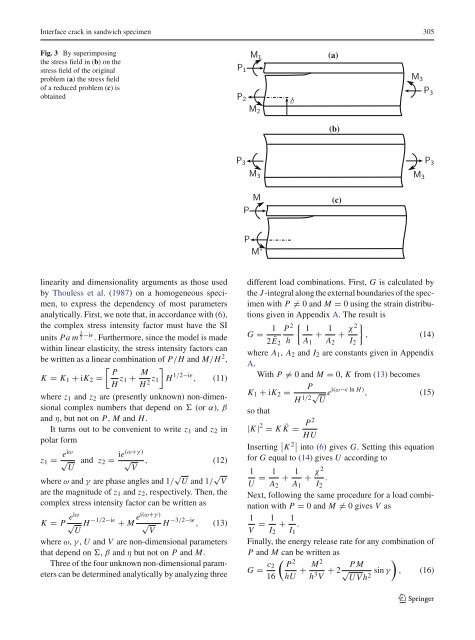Rasmus ÿstergaard forside 100%.indd - Solid Mechanics
Rasmus ÿstergaard forside 100%.indd - Solid Mechanics
Rasmus ÿstergaard forside 100%.indd - Solid Mechanics
You also want an ePaper? Increase the reach of your titles
YUMPU automatically turns print PDFs into web optimized ePapers that Google loves.
Interface crack in sandwich specimen 305<br />
Fig. 3 By superimposing<br />
the stress field in (b) onthe<br />
stress field of the original<br />
problem (a) the stress field<br />
of a reduced problem (c) is<br />
obtained<br />
linearity and dimensionality arguments as those used<br />
by Thouless et al. (1987) on a homogeneous specimen,<br />
to express the dependency of most parameters<br />
analytically. First, we note that, in accordance with (6),<br />
the complex stress intensity factor must have the SI<br />
units Pa m 1 2 −iɛ . Furthermore, since the model is made<br />
within linear elasticity, the stress intensity factors can<br />
be written as a linear combination of P/H and M/H 2 ,<br />
<br />
P<br />
K = K1 + iK2 =<br />
H z1 + M<br />
<br />
z1 H<br />
H 2 1/2−iɛ , (11)<br />
where z1 and z2 are (presently unknown) non-dimensional<br />
complex numbers that depend on (or α), β<br />
and η, but not on P, M and H.<br />
It turns out to be convenient to write z1 and z2 in<br />
polar form<br />
z1 = eiω<br />
√ U and z2 = ie(ω+γ)<br />
√ V , (12)<br />
where ω and γ are phase angles and 1/ √ U and 1/ √ V<br />
are the magnitude of z1 and z2, respectively. Then, the<br />
complex stress intensity factor can be written as<br />
K = P eiω<br />
√ U H −1/2−iɛ + M ei(ω+γ)<br />
√ V H −3/2−iɛ , (13)<br />
where ω, γ , U and V are non-dimensional parameters<br />
that depend on , β and η but not on P and M.<br />
Three of the four unknown non-dimensional parameters<br />
can be determined analytically by analyzing three<br />
P1<br />
M1<br />
P2<br />
M2<br />
P3<br />
M3<br />
M3 M3<br />
M<br />
P<br />
P<br />
M∗ δ<br />
(a)<br />
(b)<br />
(c)<br />
different load combinations. First, G is calculated by<br />
the J-integral along the external boundaries of the specimen<br />
with P = 0 and M = 0 using the strain distributions<br />
given in Appendix A. The result is<br />
G = 1 P<br />
2Ē2<br />
2 <br />
1<br />
+<br />
h A1<br />
1<br />
+<br />
A2<br />
χ 2 <br />
, (14)<br />
I2<br />
where A1, A2 and I2 are constants given in Appendix<br />
A.<br />
With P = 0 and M = 0, K from (13) becomes<br />
P<br />
K1 + iK2 =<br />
H 1/2√U ei(ω−ɛ ln H) , (15)<br />
so that<br />
|K | 2 = K ¯K = P2<br />
HU<br />
Inserting K 2 into (6) givesG. Setting this equation<br />
for G equal to (14) givesUaccording to<br />
1 1<br />
= +<br />
U A2<br />
1<br />
+<br />
A1<br />
χ 2<br />
.<br />
I2<br />
Next, following the same procedure for a load combination<br />
with P = 0 and M = 0givesVas 1 1<br />
= +<br />
V I2<br />
1<br />
.<br />
I1<br />
Finally, the energy release rate for any combination of<br />
P and M can be written as<br />
G = c2<br />
<br />
P2 M2<br />
+<br />
16 hU h3 <br />
PM<br />
+ 2√ sin γ , (16)<br />
V UVh2 P3<br />
P3<br />
123
















